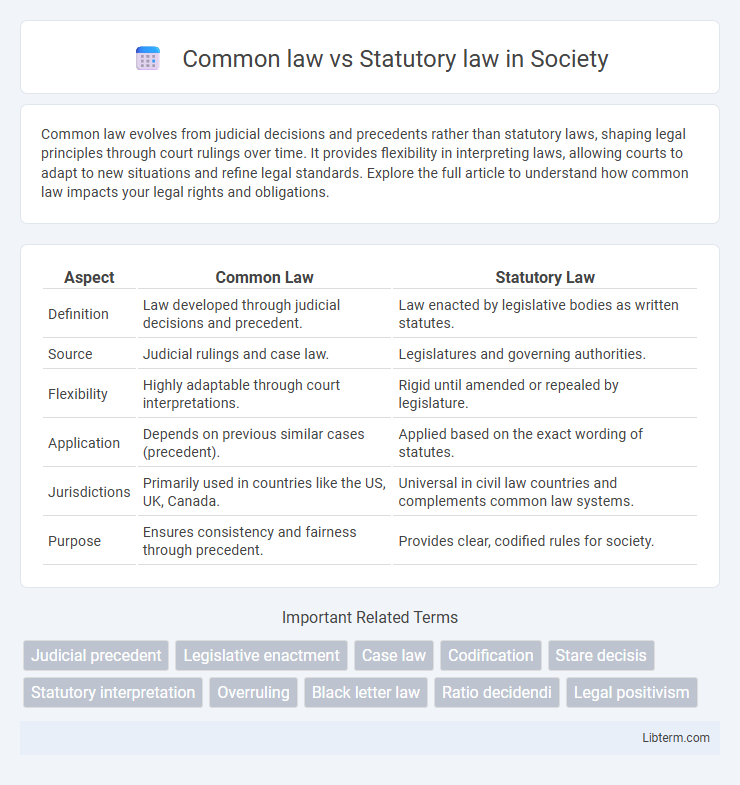Common law evolves from judicial decisions and precedents rather than statutory laws, shaping legal principles through court rulings over time. It provides flexibility in interpreting laws, allowing courts to adapt to new situations and refine legal standards. Explore the full article to understand how common law impacts your legal rights and obligations.
Table of Comparison
| Aspect | Common Law | Statutory Law |
|---|---|---|
| Definition | Law developed through judicial decisions and precedent. | Law enacted by legislative bodies as written statutes. |
| Source | Judicial rulings and case law. | Legislatures and governing authorities. |
| Flexibility | Highly adaptable through court interpretations. | Rigid until amended or repealed by legislature. |
| Application | Depends on previous similar cases (precedent). | Applied based on the exact wording of statutes. |
| Jurisdictions | Primarily used in countries like the US, UK, Canada. | Universal in civil law countries and complements common law systems. |
| Purpose | Ensures consistency and fairness through precedent. | Provides clear, codified rules for society. |
Introduction to Common Law and Statutory Law
Common law is a legal system developed through judicial decisions and precedents established by courts, emphasizing case-based reasoning and interpretative flexibility. Statutory law consists of codified statutes and legislative enactments created by government bodies, providing clear and structured legal rules. Understanding the distinction between common law's evolving judgments and statutory law's formal regulations is essential for navigating legal frameworks in common law jurisdictions.
Historical Origins and Development
Common law originated in medieval England, evolving through judicial decisions and customs established by courts, forming a body of precedents known as case law. Statutory law emerged later as legislatures began codifying rules to address specific societal needs, providing clear and written regulations enforced by government authorities. The historical development of common law emphasizes judge-made law and flexibility, while statutory law reflects formal legislative processes and systematic legal frameworks.
Definition of Common Law
Common law is a legal system based on judicial precedents and customs rather than written statutes. It evolves through decisions made by courts, where judges interpret and apply past rulings to new cases. This system contrasts with statutory law, which consists of laws explicitly enacted by legislative bodies.
Definition of Statutory Law
Statutory law consists of written laws enacted by legislative bodies such as parliaments or congresses, providing codified rules that govern behavior within a jurisdiction. It contrasts with common law, which is derived from judicial decisions and precedent rather than formal statutes. Statutory laws are explicitly documented and often address specific issues, ensuring clarity and uniform application across courts.
Key Differences Between Common Law and Statutory Law
Common law is developed through judicial decisions and precedents established by courts, while statutory law consists of laws explicitly written and enacted by legislative bodies. Common law evolves over time based on court rulings, offering flexibility in interpretation, whereas statutory law provides clear, codified rules that must be followed. Enforcement mechanisms differ as common law relies on judicial interpretation, and statutory law depends on formal legislation and statutes.
Role of Judges and Legislatures
Judges interpret and apply common law by relying on judicial precedents to resolve disputes and fill legal gaps, shaping the law through court decisions over time. Legislatures create statutory law by drafting and enacting statutes that provide explicit legal rules and frameworks to address societal issues. The interplay between judicial interpretation and legislative authority ensures a dynamic legal system balancing case-specific rulings with codified statutes.
Application in Legal Systems
Common law relies on judicial precedents and case law developed over time, allowing courts to interpret and apply legal principles flexibly in diverse situations. Statutory law consists of codified laws enacted by legislatures, providing clear and specific rules that courts must follow during application. Legal systems based on common law emphasize adaptiveness and judicial interpretation, whereas statutory law systems prioritize uniformity and legislative authority.
Advantages and Disadvantages of Each System
Common law, developed through judicial decisions, offers flexibility and adaptability by allowing courts to interpret laws based on precedent, but can lead to inconsistencies and slower legal evolution due to reliance on case-by-case rulings. Statutory law, created by legislatures, provides clarity and predictability with codified rules applicable uniformly, though it may lack adaptability and become outdated quickly without periodic legislative updates. Both systems balance structured governance and dynamic interpretation, impacting legal certainty and responsiveness in different judicial contexts.
Real-World Examples and Case Studies
Common law, exemplified by the landmark case of Marbury v. Madison, relies on judicial precedents established by courts over time, while statutory law is codified by legislatures, such as the Civil Rights Act of 1964. In real-world applications, common law shapes evolving legal principles through case rulings like Roe v. Wade, whereas statutory law provides clear, codified regulations exemplified by the Affordable Care Act. Case studies highlight that common law offers adaptability through judicial interpretation, contrasting with statutory law's structured and specific legislative mandates.
Conclusion: Implications for Legal Practice
Common law emphasizes judicial decisions and precedents, requiring legal practitioners to interpret past rulings and apply them to current cases, which ensures adaptability and consistency in legal reasoning. Statutory law, based on enacted legislation, demands precise understanding of statutory language and adherence to legislative intent, promoting clarity and predictability in legal outcomes. Combining both frameworks allows legal professionals to navigate complex legal environments effectively, balancing flexibility with formal statutory mandates.
Common law Infographic

 libterm.com
libterm.com